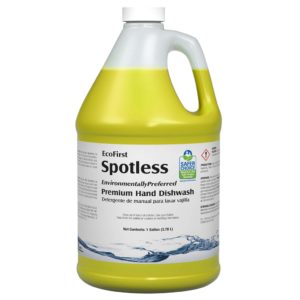As kids head back to school, we all hope that they will be entering a safe and healthy learning environment. But some products used to clean and maintain school facilities may have negative effects on kids’ health. Fortunately, it’s possible to choose safer options, not only for general cleaning products, but also for antimicrobial products and other products used to maintain school facilities.
Considering that kids spend hours a day in the classroom, the chemicals in products used for school cleaning and maintenance can have a significant effect on their health. For example, poor indoor air quality, which can be worsened by VOCs in some products, can actually reduce cognitive ability – potentially making it harder for kids to learn. Also, asthma, which is associated with exposure to some cleaning chemicals, is a leading cause of school absenteeism.
Using safer products in schools is especially important because kids can actually be more sensitive to the effects of chemicals than adults. Why? Kids have a greater intake of food, air, and water per body weight than adults do, so their exposure to environmental chemicals (such as those present in indoor air) can be greater than that of adults in the same environment. Plus, kids’ metabolic pathways are different from adults’, so they can’t always metabolize and eliminate toxic chemicals from their body as easily as adults can. Finally, during key developmental periods, such as in the womb, early childhood, and adolescence, their systems may be more susceptible to the effects of chemicals.
Of course, adults are also vulnerable to chemical hazards, and janitorial staff who use cleaning products daily are susceptible to skin conditions and respiratory problems due in part to cleaning product exposure.

So how can schools make sure the cleaning and maintenance products they’re using are safer for students and staff? Many school districts have policies that mandate the use of environmentally-preferable or safer cleaning products in school facilities, and more are working to add them. Some states also require or encourage schools to use safer products. For example, a bill currently under consideration by the California legislature, the Clean and Healthy Schools Act, would standardize green cleaning requirements for most schools in the state.
If your local school district doesn’t already have a policy in place, send them this: https://www.epa.gov/schools-healthy-buildings/cleaning-effectively-healthy-school-environment#what

One key recommendation is to source products with reputable third-party certifications – for example, EPA’s Safer Choice. This is an easy way to identify cleaning products that use only ingredients that have been reviewed for safety and confirmed to be a safer option for people and the environment. For example, products with the Safer Choice label can’t contain ingredients that are carcinogens, and overall, products must fall within a specified pH range to avoid hazards associated with very acidic or basic products. In addition to reviewing all intentionally added ingredients, third party toxicologists also consider residuals and contaminants that could present a hazard. Plus, Safer Choice-certified products must meet performance standards, avoiding concerns that green cleaning products won’t work and will result in staff frustration.
Safer Choice-certified products aren’t limited to general cleaning applications. Other important school maintenance products can also be certified, including athletic field paints, graffiti removers, deicers, and whiteboard cleaners. Even for applications where an antimicrobial product is necessary, EPA can help identify safer alternatives. Although EPA-registered antimicrobial products, which are regulated as pesticides, aren’t able to use the Safer Choice label, the Design for the Environment program works with product manufacturers to recognize antimicrobial products made with safer ingredients. These products are made with certain active ingredients, such as citric acid, hydrogen peroxide, and ethanol, that are both effective at killing disease-causing microbes in appropriate formulations, and safer for both people and the environment. Inert ingredients in the product must meet the Safer Choice standard. Visit the Design for the Environment website for a list of antimicrobial products that have been reviewed through the Design for the Environment antimicrobial project.
If you’re a parent, concerned community member, or school employee looking to implement green cleaning practices, the Healthy Schools Campaign has a guide to help advocates for children’s health work towards a green cleaning policy. Some tips include getting buy-in from other stakeholders (like parents, teachers, administrators, facilities staff, school nurses, and contract service providers) and getting started with a pilot program to test ideas and gain acceptance. Fortunately, given the number of effective (and cost-effective) safer cleaning options available today, there’s no reason kids and workers need to continue to be exposed to hazardous products.
